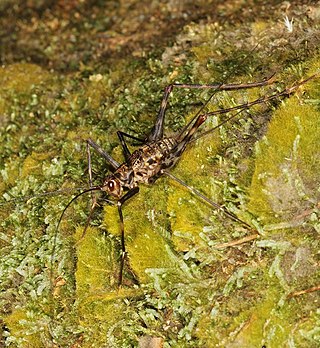The Seychelles palm frog is a species of frog that is endemic to Silhouette Island in the Seychelles. It is closely related to Gardiner's frog, Sechellophryne gardineri.

The Seychelles fruit bat or Seychelles flying fox is a megabat found on the granitic islands of Seychelles, and on the Comoros and Mafia Island. It is a significant component of the ecosystems for the islands, dispersing the seeds of many tree species. Although it is hunted for meat on some islands, it remains abundant. It is particularly common on Silhouette Island.

Vesey-Fitzgerald's burrowing skink is a species of lizard in the family Scincidae. The species is endemic to the Seychelles.

The Reunion giant tortoise is an extinct species of giant tortoise in the family Testudinidae. It was endemic to Réunion Island in the Indian Ocean.

The Aldabra flying fox is a species of megabat in the genus Pteropus. It is endemic to the Aldabra Atoll in the Seychelles, like Chaerephon pusilla, though the latter may be the same species as the little free-tailed bat.
Imperturbatia violescens is a species of air-breathing land snail, terrestrial pulmonate gastropod mollusk in the family Streptaxidae.

Rhachistia aldabrae, the Aldabra banded snail, is a species of air-breathing land snail, a pulmonate gastropod mollusc in the family Cerastidae. The species lives on one atoll in the Seychelles Islands, Indian Ocean, and is easily recognizable for its purplish-blue banded shell. The species was thought to have died out because of climate change, but was rediscovered in 2014.
Andasta is a genus of ray spiders that was first described by Eugène Louis Simon in 1895.
Argyrodella is a monotypic genus of Seychelloise comb-footed spiders containing the single species, Argyrodella pusillus. It was first described by Michael I. Saaristo in 2006, and is found on the Seychelles.
Eucarlia is a genus of spirobolidan millipedes containing six species; most of which are endemic to the island nation of Seychelles, and one native to the Indonesian island of Sulawesi. Four of the Seychelles species have been assessed by the IUCN Red List as either endangered, critically endangered, or extinct.
Cynapes wrighti is a species of spider from the family Salticidae. The species is endemic to Mahé Island of Seychelles.
Hasarius rufociliatus is a species of jumping spiders. The species is endemic to four islands in Seychelles: Curieuse, Mahé, Silhouette and Felicite.
Hyperothrix orophura is a species of millipede in the family Pyrgodesmidae. The species is endemic to Mahe Island and Silhouette Island of Seychelles.
Sitalcicus incertus is a species of harvestmen in the family Podoctidae. The species is endemic to Silhouette Island of Seychelles.
Thomasettia a genus of spiders in the family Sparassidae, with a single species, Thomasettia seychellana, first described in 1911. It has not been found since, and has been declared extinct. It was endemic to Mahe Island and Silhouette Island in the Seychelles.
Pleorotus was a monotypic genus of Seychelloise huntsman spiders containing the single species, Pleorotus braueri. It was first described by Eugène Louis Simon in 1898, and was endemic to the Seychelles. The description was based on a single male collected on Mahe Island in 1894, but none have been found in later collections, and it has been declared extinct.

Seycellesa is a genus of spiders in the family Theridiidae. It consists of only its type species: Seycellesa braueri, which is endangered and endemic to the Seychelles.
Seselphisis visenda, the Seychelles predatory bush-cricket, is a species of cricket first described by Bolivar in 1912. It is a member of the family Tettigoniidae in the order Orthoptera. It is found in the forests of the islands of Mahé, Silhouette, Praslin and La Digue in the Seychelles.

The Mahé boulder cricket is an insect species endemic to Mahé island in Seychelles. This species of cricket is only found in two localities, the Morne Seychellois National Park and "La Reserve". The species had not been recorded since 1909, until its rediscovery in 2014. It is a restricted range species, with an area of occupancy less than 10 square kilometres (3.9 sq mi) and with a very fragmented population.







